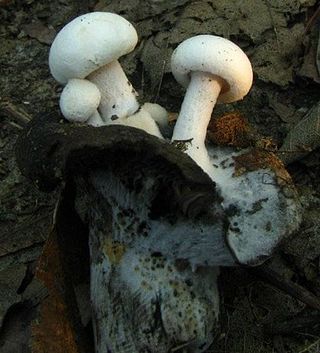Top Qs
Timeline
Chat
Perspective
Asterophora lycoperdoides
Species of fungus From Wikipedia, the free encyclopedia
Remove ads
Asterophora lycoperdoides, commonly known as the star bearer, or powdery piggyback mushroom,[2] is a species of fungus in the Lyophyllaceae family. It grows as a parasite, mostly on Russula species, and is found in North America and Europe[3].
Remove ads
Taxonomy
The species was first named as Agaricus lycoperdonoides by French mycologist Jean Baptiste Francois Pierre Bulliard in 1784.
Description
The cap is white but soon covered in brown powder, growing up to 2 centimetres (3⁄4 in) wide.[4] The gills are adnate and fairly distant, sometimes forked. The stems are up to 5 cm (2 in) long.[4]
Asexual spores are produced on the mushrooms cap which enable the organism to clone itself easily. The spores, called chlamydospores[3], are star-shaped, hence the name 'star bearer'. It is regarded as nonpoisonous but inedible.[5][6]
Asterophora parasitica is similar but has more conic caps, its gills are typically more developed, and its chlamydospores are fusiform rather than star-shaped.[7]
Remove ads
Habitat and distribution
It grows as a parasite on other mushrooms, mainly those in the genus Russula.[4] It can be found from July to September in eastern North America, somewhat later on the on the West Coast.[4] It can be found August to November in temperate Europe, and can be locally common.[3]
References
External links
Wikiwand - on
Seamless Wikipedia browsing. On steroids.
Remove ads

